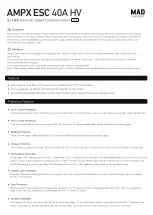
2-2
Rev 2.2, 10/31/94
The 601 allows you to set the signal levels in three different locations, which allows you to
make the best tradeoff between headroom and dynamic range. The analog inputs each have
gain controls to help you run these stages as hot as possible, without clipping. After conversion
to digital form, some signals may be too hot for any signal processing that results in an
increasing signal level. Thus, the 601 has a digital gain control that allows you to raise or lower
the level sent to the digital processors. Finally, there is an overall digital output gain control
allowing you to restore the signal level to "normal."
2.4 Equalization
Equalization is nothing more than selectively (or not) amplifying a signal based on frequency.
Since audio signals consist of combinations of fundamental signals and their harmonics,
changing the tonality or the spectral balance of a signal involves nothing more than altering the
relationship of the fundamental to its harmonics, and of the harmonics to themselves. Each
harmonic is responsible for one aspect of the audible character of a signal; knowing these
relationships allow you to quickly zero-in on the correct frequency range of the signal and
quickly apply boost or cut to enhance or correct what you are hearing.
The audio spectrum has several critical portions that are responsible for our perceptions of
sounds that we hear:
1
2.4.1 Power and Fullness.
In the very low bass region lies the threshold of feeling, where the lowest sounds, like wind, room
effects, and distant thunder, are felt, rather than heard. In the upper half of the first octave of
this range, research has shown that the fundamentals of piano, organ and even the harp reach
well into this range. Harvey Fletcher (of Fletcher-Munson fame) charted the sensitivity of the ear
for various parts of the spectrum at levels that are lower than those of reality. Fletcher's
compensation curves (the well known Fletcher-Munson curves) show that for equal loudness in
this range at lower recorded and reproduced levels shows requirements for tremendous boosts,
on the order of 10 to 30 dB. Aside from the subjective effects of this range, the ability to control
unwanted sounds in this range is equally important to subdue stage rumble and outside traffic
noise (especially important where there are subways beneath buildings!). Overemphasis caused
by close cardioid microphone placement can cause muddiness in the overall sound;
attenuating (cutting) the very-low-bass region can greatly improve overall clarity.
2.4.2 Rhythm and Musical Foundation.
In the bass region, most of the low, grave tones of the drum and piano can be found. Here we
can also find the fundamentals of the rhythm section, as well as the foundation of all musical
structure.
It was Leopold Stowkowski who said "If I had a thousand bass viols I could use them all!" This is not
as extreme as it may sound. A bass viol, even though it is reinforced by its sounding board,
generally plays single notes and possesses little dynamic range. In a large orchestra, as many as
1
The majority of the material in section 2.4 is taken from "Equalizing for Spectral
Character," Langevin Corporation, 1966 Catalog.
Range
Frequencies
Musical Location
Very Low Bass
16-64 Hz
1st and 2nd octaves.
Bass
64-256 Hz
3rd and 4th octaves.
Midrange
256-2048 Hz
5th, 6th, and 7th octaves.
Lisping Quality
3000 Hz
Between the 7th and 8th octaves.
Presence Range
4750-5000 Hz
Between the 8th and 9th octaves.
Brilliance
6500-16 kHz
Part of the 9th through the 10th octave.
Содержание 601
Страница 46: ...4 18 Rev 2 2 10 31 94 This page is blank believe it or not ...
Страница 48: ...4 20 Rev 2 2 10 31 94 Notes ...
Страница 50: ...5 2 Rev 2 2 10 31 94 Notes ...
Страница 70: ...7 16 Rev 2 2 10 31 94 Notes ...
Страница 72: ...8 2 Rev 2 2 10 31 94 Notes ...
Страница 74: ...9 2 Rev 2 2 10 31 94 Notes ...
Страница 78: ...11 2 Rev 2 2 10 31 94 Notes ...
Страница 126: ...D 12 Rev 2 2 10 31 94 Notes ...
Страница 138: ...G 8 Rev 2 2 10 31 94 Notes ...














































